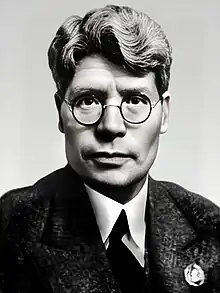Ivan Gubkin
Ivan Mikhailovich Gubkin (Russian: Ива́н Миха́йлович Гу́бкин; September 21 [O.S. September 9] 1871 – 21 April 1939) was a Soviet and Russian geologist and president of the 1937 International Geological Congress in Moscow. He was a petroleum geologist particularly interested the region between the Volga and the Urals.
Ivan Gubkin | |
|---|---|
 Gubkin in 1937 | |
| Born | 21 September 1871[1] |
| Died | 21 April 1939 (aged 67)[2] |
| Alma mater | Petersburg Mining Institute[2] |
| Occupation | Petroleum geologist |
| Awards | Lenin Prize (1931) Order of Lenin (1937) Order of the Red Banner (1939)[1] |
| Scientific career | |
| Institutions | Moscow Mining Academy[1] |
| Doctoral advisor | Karol Bohdanowicz[1] |
Gubkin was born to a poor farmer's family in the Belgorod area in the South of Russia. In 1895, aged 24 he moved to Saint Petersburg, but, due to the lack of money, could only enroll to a teachers institute. Only in 1903, he could enter the Petersburg Mining Institute. During his studies there, and after graduation in 1910, he worked at Maykop, Kuban, Taman and Absheron oil fields.[1][2]
In 1920 Gubkin was appointed to lead a government commission that was tasked to study the origin of the Kursk Magnetic Anomaly. The commission proved the relation between the anomaly and the nearby iron ore deposits. In 1921, Gubkin joined the Communist Party. He was elected to the Russian Academy of Sciences in 1929, and served as its vice-president from 1936 to 1939. Gubkin's book "The Study of Oil" (1932) developed theory on the origins of oil and the conditions necessary for the formation of oil deposits, and laid out the principles of oil geology. He led the studies of the Kursk Magnetic Anomaly from 1920 to 1925, which eventual led to the discovery of huge iron deposits. Gubkin was the editor of the journal Problems of Soviet Geology. During the first and second Five-Year Plans, he was chairman of the "Production Committee" of the Academy of Sciences (1930–1936). In 1936 he became Vice President of the Soviet Academy of Sciences. Gubkin died in Moscow in 1939, and was buried at the Novodevichy Cemetery.[1]
Gubkin was well known to American geologists, as Goubkin. He attended the Annual Fieldtrip of the American Association of State Geologists in 1917,[3] and was the only member of the American Association of Petroleum Geologists from the Soviet Union.[2]
Named in his honor

- Academician Gubkin Prize for accomplishment in petroleum science and engineering (1949–present)[1]
- Gubkin Russian State University of Oil and Gas
- Gubkin, a town in Belgorod Oblast, Russia[1]
- Gubkinsky, a town in the Yamalo-Nenets Autonomous Region of Russia[1]
- Gubkina Street in Belgorod, Grozny, Kazan, Krasnodar, Moscow, Murom, Novocherkassk, Novyi Urengoi, Omsk, Volgograd, Yekaterinburg and other sities.[1]
References
- Биография Ивана Губкина Archived 30 October 2021 at the Wayback Machine. Tass.ru. 21 September 2021
- Safonov, Anatole (1939). "Ivan Mikhailovitch Goubkin (1871–1939)". AAPG Bulletin. 23 (8): 1283–1284. Archived from the original on 10 July 2020. Retrieved 30 October 2021.
- Hotchkiss, W. O. (1917). "Annual Field Trip of the American Association of State Geologists". Science. 46 (1197): 556–557. Bibcode:1917Sci....46..556H. doi:10.1126/science.46.1197.556. PMID 17756849. Archived from the original on 30 October 2021. Retrieved 30 October 2021.
Further reading
- Solov'Ev, Yu. Ya. (2007). "On the 125th birthday of Dmitrii Ivanovich Mushketov (1882–1938)". Stratigraphy and Geological Correlation. 15 (4): 443–448. Bibcode:2007SGC....15..443S. doi:10.1134/S0869593807040090. S2CID 128791381.